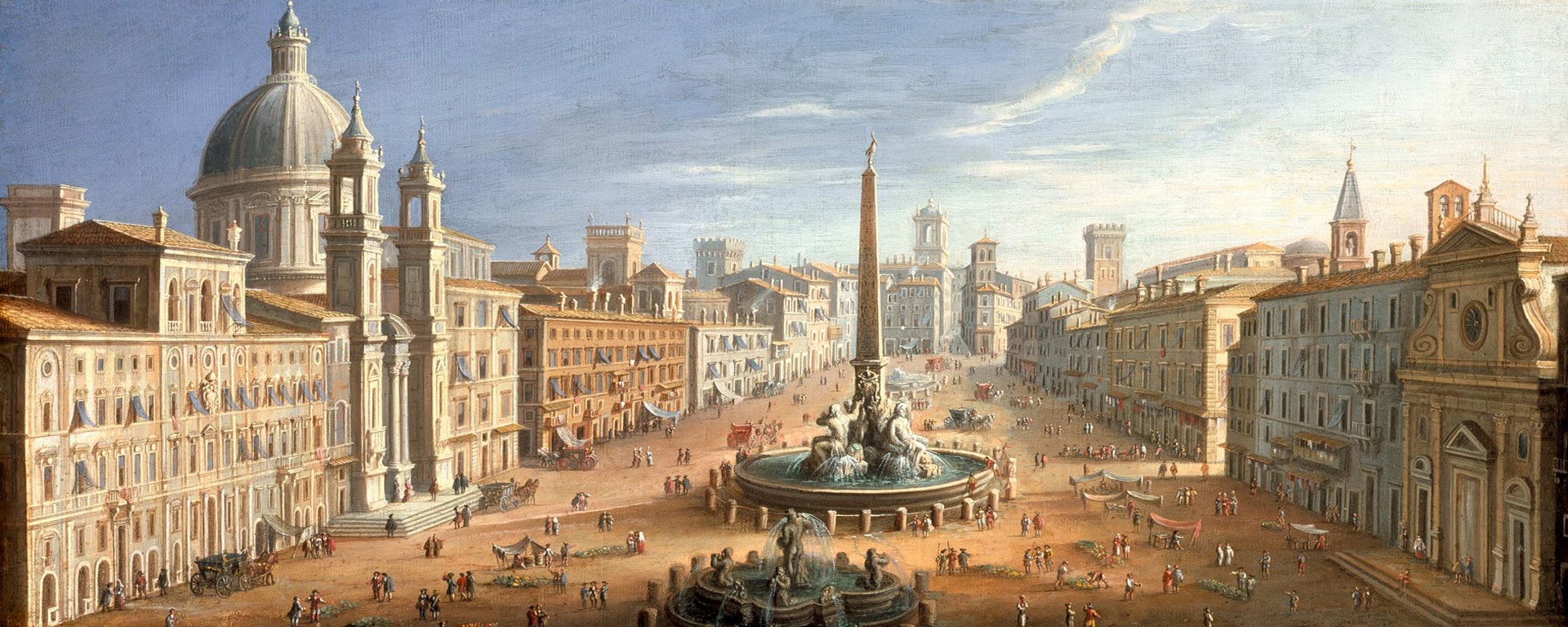
Piazza Navona
Piazza Navona is one of Rome’s most beautiful squares. Like most squares in Rome, the modern Catholic phase was built upon ancient Roman foundations.
piazza novona
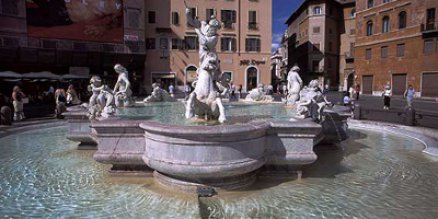 This square was initially the chariot racing track of the Emperor Domitian. Domitian was the third Emperor of the Flavian dynasty and was in power from 82 to 96 AD.
This square was initially the chariot racing track of the Emperor Domitian. Domitian was the third Emperor of the Flavian dynasty and was in power from 82 to 96 AD.
He is the emperor who completed the basement or hypogeum of the colosseum.
This stadium was known as Circus Agonalis or the games stadium. Agonalis is the Greek word for games and it was mainly Greek sports which were played here, running, javelin throwing etc.
Over time the word agonalis became corrupted colloquially to agona then navona.
The modern square which dates from the sixteen hundreds onwards was built directly upon the Roman foundations of Domitian’s stadium. The curved plan of the road exactly matches that of the racing track.
The ruins of this stadium are still visible at the north end of the piazza.
The second phase of building started in the fifteenth century with people building houses over the Roman foundations.
Modern Rome is literally built over the foundations of ancient Rome here. The Catholic Church then got involved in the act and started to build over the stadium according to a plan.
There are three fountains in this square. The fountains at either end of the piazza were designed by Giacomo della Porta in 1574 – 1576.
He is the man who completed Michelangelo’s work in Rome, most notably the Dome of St. Peter’s Basilica and who did the fountain outside the Pantheon.
piazza navona fountain
The Fountain of Neptune
 At the north end of the piazza is Fountain of Neptune and represents Neptune, the Roman God of the Sea,nstanding on a rock in the middle and fighting a sea monster or octopus.
At the north end of the piazza is Fountain of Neptune and represents Neptune, the Roman God of the Sea,nstanding on a rock in the middle and fighting a sea monster or octopus.
The other guys blowing on conch shells are Tritons, his assistants or the aquatic civil service.
The Fountain of the Moor
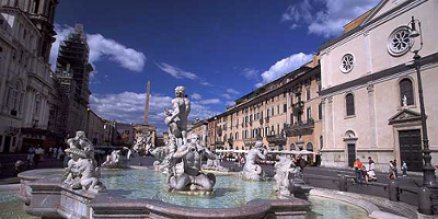 The fountain on the southern end is practically identical but is called the Fountain of the Moor or African and has what was considered to be a bearded African in the centre.
The fountain on the southern end is practically identical but is called the Fountain of the Moor or African and has what was considered to be a bearded African in the centre.
During the middle ages, Romans were strictly clean shaven and beards were only to be seen on African traders.
This bearded African is simply just a statue of a Triton wrestling a dolphin.
the fountain of the four rivers
 The most interesting fountain of the three is the one in the middle of the square.
The most interesting fountain of the three is the one in the middle of the square.
This is the Fountain of the Four Rivers which was designed by GianLorenzo Bernini and unveiled in 1651.
As you can tell Bernini designed a lot of modern Rome.
He was working so much that all the other sculptors were complaining to the Pope that they could not find work and had to work for Bernini as assistants.
Pope Innocent X decided to have a competition for the contract of the building to let these artists bid for the job.
To appease the artists he forbade Bernini to enter the competition.
Bernini was quite disappointed as he desperately wanted to enter the competition.
Having worked so long in Rome and being a friendly man, he had a lot of contacts in the art world.
One of these contacts was the Pope’s niece. She told him to build his model and she would put it in her house in a room that the Pope would pass the next time he was over for dinner.
So he gave her the model. The Pope indeed passed the model and according to reports he stopped in front of it, totally distracted by it.
He asked his niece who made the model and where was it for.
She told him, Bernini did and he intended it for Piazza Navona. The pope sighed and said, ‘if you do not wish to employ Bernini, you must not look at his models’.
So Bernini got the contract.
There are four figures and each of these is a personification of one of the four major world rivers of each of the four known continents at the time.
The Ancient Romans believed in River Gods and Bernini chose to identify each god with a different icon local to each case.
On the right is the Nile in Africa with his face covered, as they did not know where the source of it was at the time.
Behind him is the Danube in Europe.
On the left is the Rio della Plata in South America and behind that is the Ganges in India.
rome piazza
Piazza Navona Obelisk
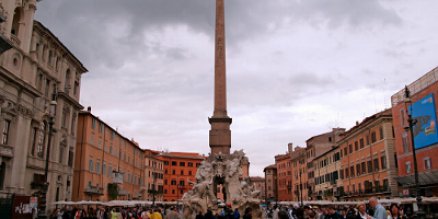 The obelisk which is atop the fountain was put there during Bernini’s construction.
The obelisk which is atop the fountain was put there during Bernini’s construction.
It was a Roman copy of an Egyptian original which used to be in the Circus of Maxentius just outside Rome.
On the very top of the Obelisk is a dove with an olive branch. This came from the family crest of Pope Innocent X.
The dove symbolises the Holy Spirit in Catholicism and the olive branch symbolises peace.
The dove is pointing to the south but Dan Brown says it points to the west to Castel Sant’ Angelo to suit his novel.
The Church of Saint Agnes in Agony
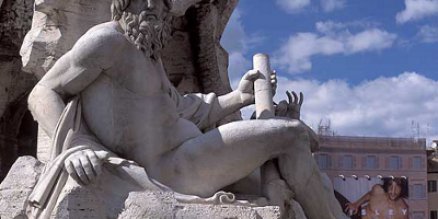 The church in front of the main fountain Saint Agnes is Agony.
The church in front of the main fountain Saint Agnes is Agony.
The Agony refers to Piazza Navona’s first name Agonalis.
According to legend, she was a Christian who was dragged in to the seating area of the stadium by four Roman soldiers who intended to rape her.
Once they had her clothes off, she spontaneously grew hair all over her body.
This miracle makes her a saint. The Roman soldiers were petrified and killed her on the spot.
This action makes her a martyr. Pope Innocent X, came from a noble family called the Pamphilis and his family owned the place to the left, which is now the Brazilian Embassy to Italy.
In 1650 they decided they wanted to build a church next door and initially commissioned Girolamo Rainaldi to build it.
He built the foundations. He was succeeded by Francesco Borromini from 1653 – 1657.
He is responsible for the majority of the church, the concave and convex or curving front being a particular technique of his.
Bernini built two clock towers for the church which were not properly balanced, a mistake he also made with St. Peter’s Basilica and the Pantheon.
In all cases his towers were removed and Borromini built his own ones, which still stand.
This was a big blow for Bernini, who was considered to be Rome’s greatest architect.
It is also quite ironic when you consider that Bernini had insulted Borromini before he began.
Before the church was completed, Borromini had a nervous breakdown and was discharged from working on the church.
His designs were finished by Carlo Rainaldi, son of the first architect, making it truly a family building.
Piazza Navona Tour
Piazza Navona is one of the most beautiful squares of Rome. It can be added to a walking or driving tour of the Eternal City by the link in the menu.
3 hour Walking Tour of the Piazzas and Fountains of Rome Italy
Rated 5.0/5 based on a selection 10 customer reviews out of thousands.
